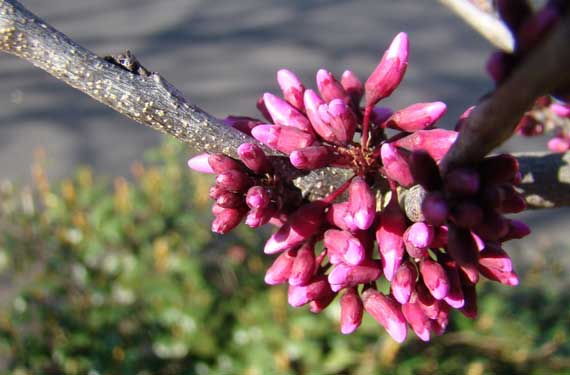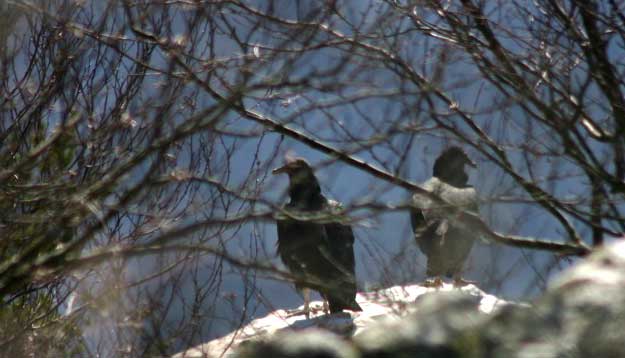Musings

Sunny, gorgeous day, with some blooms spreading their scent; the few pears that remain around the Va-Hi corner are in full glory.
I know this as a Japanese magnolia, apparently originally from China, but Wikipedia has so much info about magnolias, I’ll just back off and say, Wheeeoooo!
Posted at 8:21 PM |
Comments Off on aka Big-flower

Despite the cloudy overcast that haunted us all day, the redbuds are almost ready to bloom (photo from yesterday, which was sunny).
Posted at 5:18 PM |
Comments Off on Ready redbuds

Today’s NYTimes has a series of stories and graphics that make me quite uneasy. I do wonder what They (meaning anybody out there, individual or corporate, private or government) can learn about me from my web activity, carried out from the safety of my own desk chair/couch/etc. I know They do want to know what I’m up to, so as to market Stuff to me more efficiently—highly targeted marketing is what They tell clients They provide.
Take the time to look at the graphics: 1) a simple bar graph of frequency of data collection at several domains at least several of which you probably visit regularly, including FOX, AOL, Yahoo, Google, Amazon, EBay, and Wikipedia (watch out!); 2) a table of the data behind the bar graph along with another pair of bar graphs that amplify all this; and 3) a blog discussion of the whole situation.
My conclusion: 1) make sure I have my doubleclick opt-out cookie in place; 2), regularly delete cookies; and, 3) assume strangers can see what I’m up to, maybe in considerable detail.
Which is what Eliot Spitzer apparently forgot. Well, maybe not about web tracking, but at least that a phone tap can reveal all. And that nobody’s immune to them in the good old US of A….
Posted at 4:58 PM |
1 Comment »

To a great degree, our vocabularies reflect the kinds of things we feel a need to express. In other words (haha), the words we originate, use and keep current in our languages reflect the things we feel a need to say. Thus, unfamiliar words judged archaic by our dictionaries are words for things we no longer talk about—or for things for which we have other or newer terminology.
One category of words that are now uncommon in American English refer to landscape features. A quick glance at place names across the British Isles reveals myriad examples, which include holm, -stead, and heath. Suffixes -bridge and -ford remain current in our vocabularies and thus are self-explanatory.
Today’s vocabulary*: holm
a flat piece of ground adjacent to a river that floods when the water level is high
Today’s vocabulary: -stead
suffix referring to place or town, of Germanic origin and related to the Dutch stad
Today’s vocabulary: heath
an area of open, uncultivated land vegetated with low vegetation like gorse, heather, and grasses [differs from forests or cultivated lands, for example]
* Definitions adapted from Apple dictionary.
Posted at 6:40 PM |
Comments Off on ≠Back talk

Today’s All Things Considered included an interview by Jacki Lyden with an arachnologist named Gustavo Hormiga about spider species he’s identified—that’s how Lyden puts it; on his web page, Hormiga writes that his research focuses on the systematics and evolutionary biology of spiders, with emphasis on orbweavers and their close relatives (Orbiculariae).
Interesting and recommended.
I was surprised, however, that they didn’t work into the story any comment about the fact that the scientist’s surname translates as ant.
Extra credit if you know who El Hormigón—meaning The Big Spider—is!
Posted at 6:04 PM |
Comments Off on Arach-news

Ok. Here’s another popular culture version of prehistory, this one the movie 10K BC. With trepedation, I checked out the NYTimes review and immediately a word I’d never seen before jumped out at me. Was this an archaeology term I’d missed (and how?)? Or popular culture I’d missed—maybe a insurance commercial or two?
Ah, Google informed me—the latter. A.O. Scott’s word snuffleupagus is a lower-case corruption of the name of a character on Sesame Street, Aloysius Snuffleupagus—a superhuman sized puppet that looks something like a tuskless mammoth/mastodon.
And, yet, Scott uses the word as if it is a synonym for mammoth/mastodon, or as if it is a real species term:
…the Yagahl, a tribe of snuffleupagus hunters…
and:
…the big, climactic fight, complete with an epic snuffleupagus rampage…
FYI NYT and A.O. Scott: mammoth≠mastodon≠ snuffleupagus (or even Snuffleupagus).
Note: this etymological snafu bothered me so much I was distracted from the other prehistoric misinformation I’m sure the movie dispenses….
Posted at 11:39 AM |
4 Comments »

Rose quartz, if I don’t miss my guess, but I’m no geologist….
I had never thought of managing a garden to increase insect life in general (not just butterflies—sorry KW—for example). Actually it’s just a smokescreen for managing for biodiversity and native species.
No more privet. No more nandina. No more Acer palmatum. Sadly, no more daffodils or pansies, both blooming now….
Posted at 10:22 PM |
Comments Off on Gardening philosophy

It’s the end of an era tonight; we said goodbye to our lovely houseguest. She left via Amtrak, cold-bound….
Science note
I’ve known to avoid good old MSG for years, but today I found out that there’re a whole raft of nasty sibling compounds lurking in our foods.
Since the 1970s, MSG has sidled back onto American supermarket shelves, under assumed names: hydrolyzed proteins, yeast extracts, protein concentrates and other additives that are not labeled as MSG but, according to nutritionists and the United States Department of Agriculture, are essentially the same thing: synthetically produced glutamates.
The whey protein concentrate and liquid aminos that many Americans buy at health food stores are also, essentially, pure glutamate…
According to USDA guidelines, “labeling is required when MSG is added as a direct ingredient.” But other glutamates—the hydrolyzed proteins, the autolyzed yeasts and the protein concentrates, which the USDA acknowledges are related to MSG—must be identified under their own names.
Alternatively, they may also be included under certain terms, like vegetable broth or chicken broth. Thus, these ingredients are now routinely found in products like canned tuna (vegetable broth is listed as an ingredient; it contains hydrolyzed soy protein), canned soup, low-fat yogurts and ice creams, chips and virtually everything ranch-flavored or cheese-flavored.*
Ick. Ick. And ick again.
* From Julia Moskin article in today’s NY Times.
Posted at 8:54 PM |
2 Comments »

The pool just above the Pocket Falls, in Sunday’s sun.
Looking forward to hearing the election results from todays voting/caucus activity, fully realizing that this news probably won’t surface until tomorrow—or possibly later.
Posted at 6:13 PM |
Comments Off on Waiting for state-change

This was our biggest critter sighting on Sunday, two black vultures (I think)—Coragyps atratus. We were hanging out in the sunshine on rocky promontories overlooking the valley, and they stayed on the next rock the whole time we were on our rock. The spot was labeled “High Point” on the Garmin map, and the cartographers were not incorrect.
Posted at 10:30 PM |
Comments Off on Black vultures









